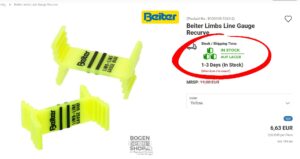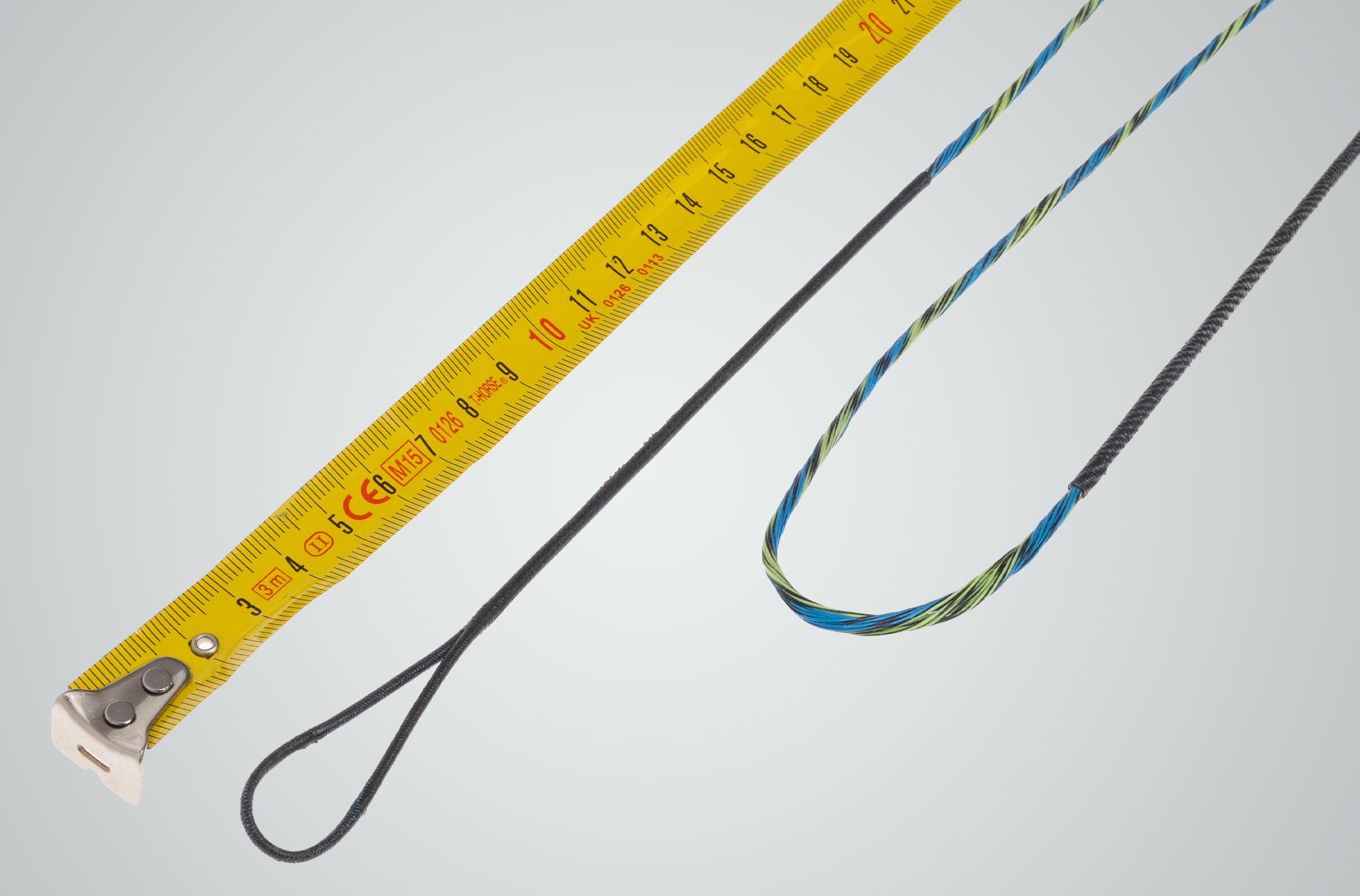
Warning!
This blog article is intended to thoroughly explain the relationship between bow length and string length. However, this information is NOT REQUIRED to order the correct string from our shop. On the contrary: if you skim this article or only read halfway through, you are more likely to order the wrong string than before. This is not a joke but rather our practical experience and the reason for this warning.
Summary:
The selection in the shop always refers to the bow length. For a 70″ bow, simply select 70″ — you don’t need to worry about the actual string length. Exceptions to this rule are rare, and it is ALWAYS mentioned in the product description what the selection refers to. Therefore, please always pay close attention to the product description, especially for strings.
Have you read the warning and the summary of the article above? If so, and if you still want to know more about the relationship between string length and bow length, please read on.
This blogpost is about a topic that is especially difficult for newcomers to archery and that often causes confusion: the string length.
If you have any of the following questions and stumbled across this post, I probably have an answer for you:
- Does a bowstring have to be shorter than the length of the bow? If so, by how much?
- What string length do I need for a 64″ / 66″ / 68″ / 70″ recurve bow?
- What string length do I need for a longbow?
- What string length do I need for an horse bow?
- What string length do I need for a compound bow?
- I have a bow, but I don’t know how long it is. How can I find a suitable string for it?
- I have a string, but I don’t know the length or what bow length it is suitable for. How do I find out?
Does a bowstring have to be shorter than the length of the bow? If so, by how much?
First of all: Yes, the string must be shorter than the total length of the bow. To string a bow, you need to push the tips towards each other so that the bow is under tension even before you draw it. This can only work if the string is shorter than the bow.
The AMO (short for Archery Manufacturers Organization), a U.S. manufacturer and dealer organization and direct predecessor of the ATA (short for Archery Trade Association), published a booklet (AMO Standards) as early as February 1968 with standards for archery that are still used today. In it you can find the specification that a bowstring should be 3 inches shorter than the bow length.
In fact, it is the other way around. A 70 inch bow is defined as a bow that requires a 67″ long bowstring. It doesn’t matter how long the bow actually is. And the required string for a bow is a string of a certain length so that a correct brace height can be achieved.
Theoretically, that’s all you need to know.
That might sound strange at first. But anyone who has ever tried to measure the length of a bow will immediately understand why they came up with the idea of basically putting the cart before the horse 50 years ago. It is almost impossible to correctly measure the length of a bow. If you try to measure along the shape of the bow, you would actually have to measure along the center, through the neutral axis of the bow. Since this is not possible, there are instructions on the Internet to measure along the inside of the bow (bow belly, or the side towards the archer). Others suggest placing a tape measure on the back of the bow (the side facing the target). Sometimes the measurements follow the shape of the riser, in other cases they are taken at the end of the limb in a straight line „through“ the middle part of the bow.
If I have a 70″ bow in front of me, I will find the 70″ somewhere via one of these approaches. But that is not really helpful.
But more about that in the answer to the last question in this blogpost.
In any case, not all manufacturers adhere to this norm, which is why you can also find people telling you that the string of a recurve bow has to be 4″ shorter than the bow length. If you take the AMO standard seriously, this is of course nonsense. If I need a 66″ string, at least according to the standard, I simply don’t have a 70″ bow, but a 69″ bow. As I said, the idea was that the string length determines the length of the bow, not the other way around!
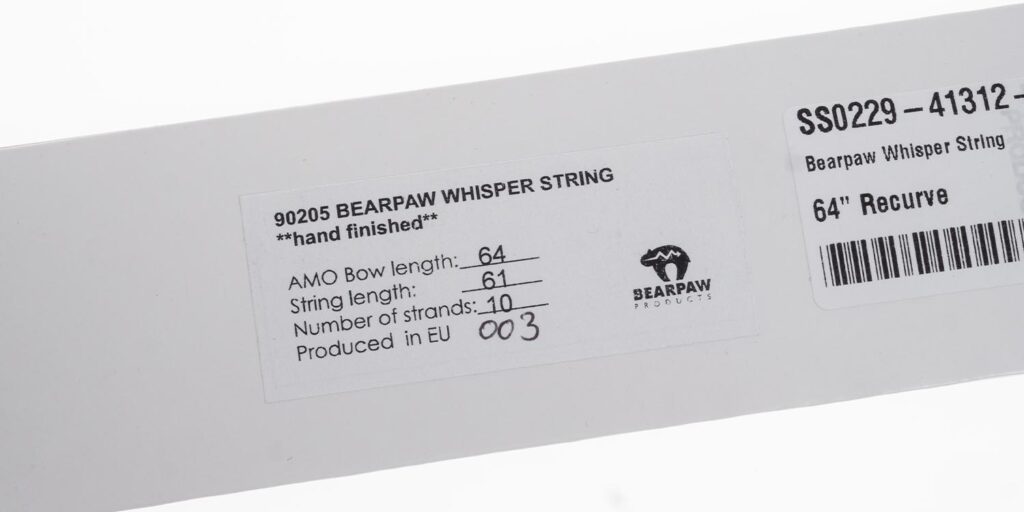
When the AMO established these standards, the bows looked significantly different than they do today. In the course of time, the one-piece recurve bows were replaced by take-down bows. Later came ILF, an industry standard to which almost all manufacturers adhere today. Through CNC manufacturing, risers today have the wildest shapes and some manufacturers still experiment with the recurve—the actual curvature of limbs—to this day.
Thus, nothing is really clear and simple. But you can still remember that the string of a recurve bow usually is 3 to 4 inches shorter than the bow.
What string length do I need for a 64″ / 66″ / 68″ / 70″ recurve bow?
If the string for a modern recurve bow is to be 3-4 inches shorter than the bow length, we get the following values:
| Bow Length | Recommended String Length |
|---|---|
| 54″ (137 cm) | 50″ – 51″ (127 cm – 129.5 cm) |
| 56″ (142 cm) | 52″ – 53″ (132 cm – 134.5 cm) |
| 58″ (147.5 cm) | 54″ – 55″ (137 cm – 139.5 cm) |
| 60″ (152.5 cm) | 56″ – 57″ (142 cm – 145 cm) |
| 62″ (157.5 cm) | 58″ – 59″ (147.5 cm – 150 cm) |
| 64″ (162.5 cm) | 60″ – 61″ (152.5 cm – 155 cm) |
| 66″ (167.5 cm) | 62″ – 63″ (157.5 cm – 160 cm) |
| 68″ (172.5 cm) | 64″ – 65″ (162.5 cm – 165 cm) |
| 70″ (178 cm) | 66″ – 67″ (167.5 cm – 170 cm) |
| 72″ (183 cm) | 68″ – 69″ (172.5 cm – 175.5 cm) |
| 74″ (188 cm) | 70″ – 71″ (178 cm – 180.5 cm) |
If the manufacturers no longer adhere to the AMO standard, they would actually have to tell you what length the bowstring should have. But in fact, almost all manufacturers of modern recurve bows do neither.
Thus, it depends on the model and the limbs. Bows with Formula limbs differ slightly from the usual ILF limbs and risers and limbs with screw fittings are a whole different can of worms. Limbs with very strong recurve will need a slightly different string length than those with less curvature.
For comparison, let’s look at the standard string length of some manufacturers. For Avalon and Shocq it is 164 cm for 68″ bows and 169 cm for 70″. The American manufacturer GAS Bowstrings builds strings for 70″ bows with a length of 66 9/16″, so they are 3.44″ shorter than the bow. And coincidentally, that’s exactly 169 cm. Apparently they already switched to the metric system!
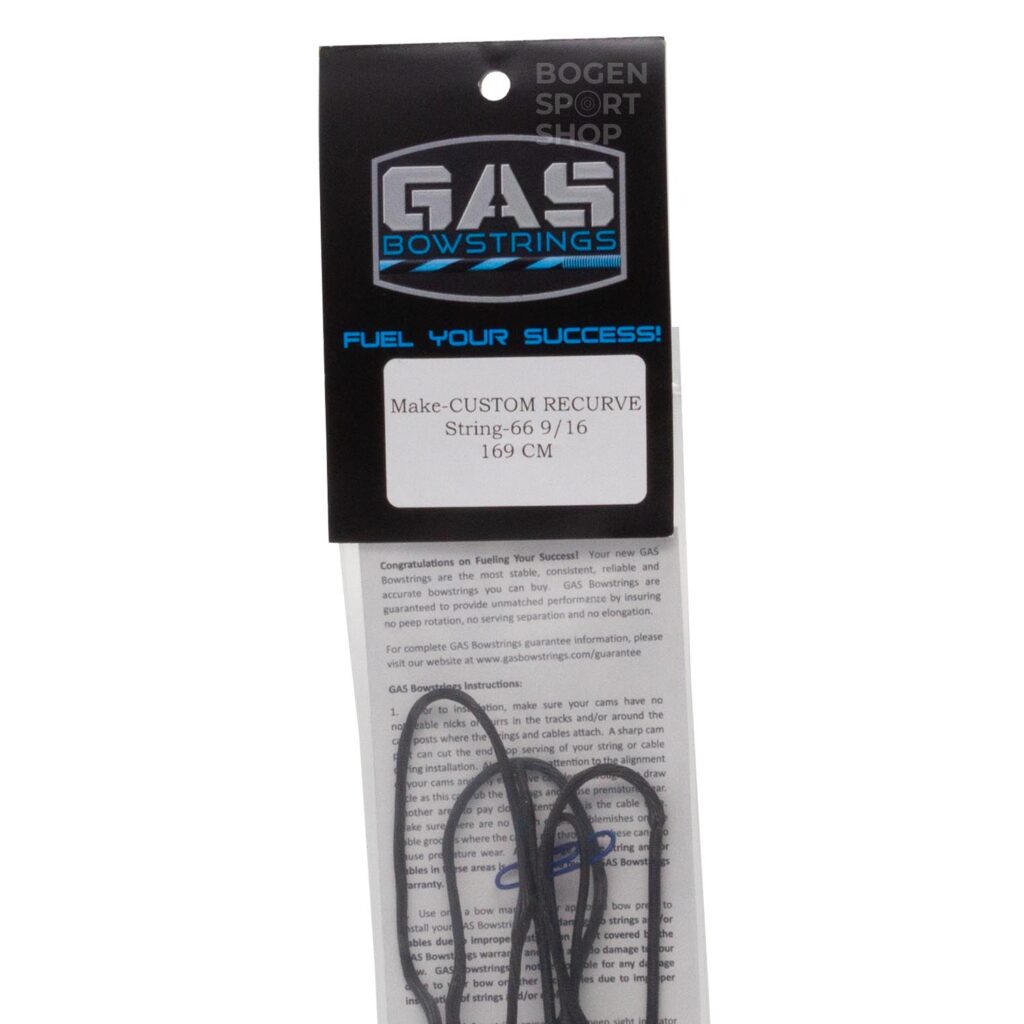
Nitro Strings (UK) makes their strings a little bit longer. The string for 70″ bows is e.g. 66 3/4″ or 169.5 cm long. So 3.25″ shorter than the bow. For 68″ it is 65″ or 165.1 cm. So here we are at the upper end of the recommended string length from the table above.
Also, as a rule of thumb, a deviation of 1/2″ or a little more than 1 cm can be compensated for by adding or removing twists in the string. If the string length deviates from the required measurement by more than 1/2″, adding or removing twists will probably not going to do it anymore. In that case, you need a string with a more suitable length.
What string length do I need for a longbow?
For the longbow, the same applies as for the recurve, but the simpler shape usually makes it easier to measure the bow length. Even with longbows, the AMO rule cannot be applied with certainty, the bowstring sometimes only need to be 2.5″ shorter than the bow length.
What string length do I need for an horse bow?
This question is answered quickly, because horse bows come in so many different shapes and sizes that there is no rule of thumb. Here, the manufacturer must specify a recommended string length, or you have to determine it yourself.
What string length do I need for a compound bow?
It doesn’t get any more complicated than with the compound bow! Here, there is simply no longer any connection between the length of the string and the length of the bow.
There are single-cam bows where the string runs twice along the entire length of the bow. In any case, with compound bows, the string is „unwound“ from the cam during draw and must therefore be much longer, usually longer than the bow. In addition, there are the cables. These are available in countless designs. The entire set of string and cables can consist of up to 5 individual parts, which must all be made to specification by the manufacturer.
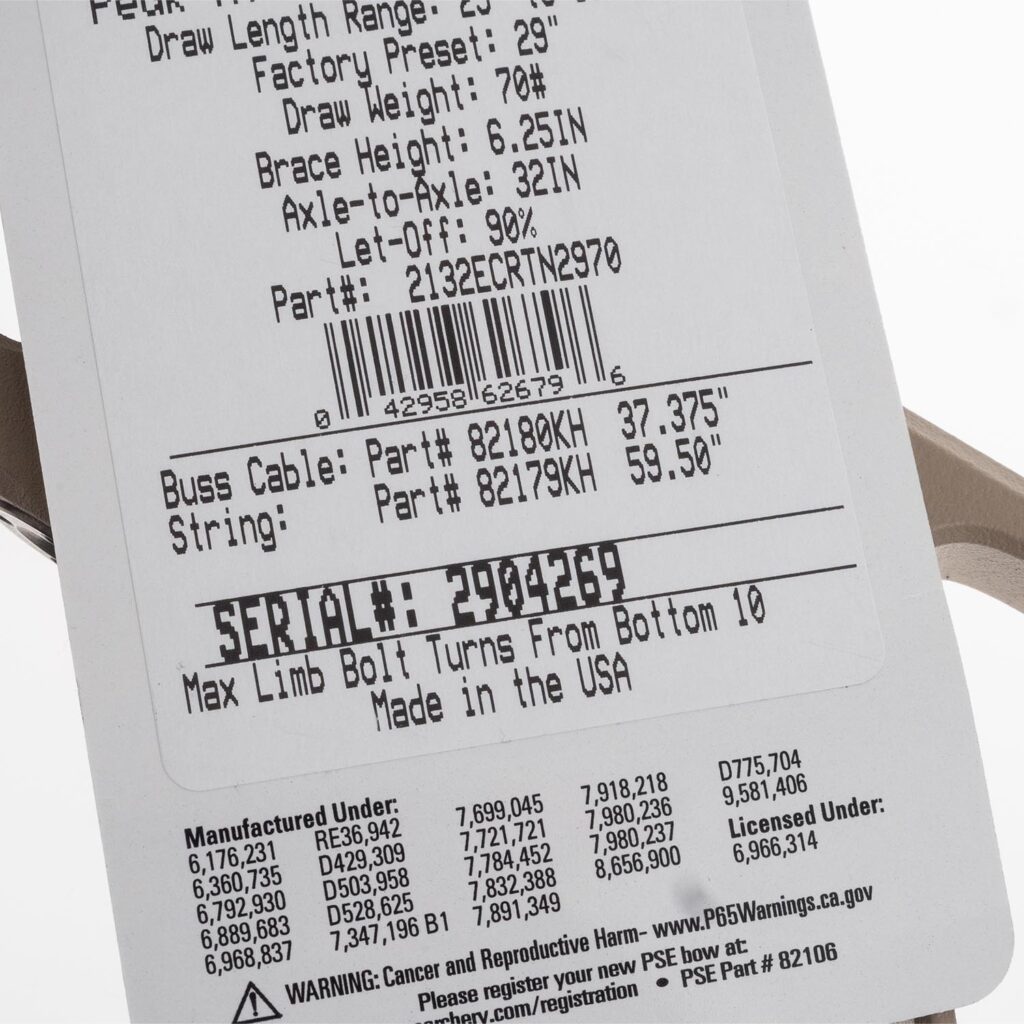

The manufacturers of compound bows therefore provide a list of lengths. Sometimes the corresponding info is attached to the bow in form of a tag with all the bow’s data on it. Often databases can be found on the manufacturer’s website. Some suppliers of compound strings have also collected data on many models themselves (e.g. GAS Bowstrings, Flex or Nitro Strings) and offer the production of matching sets according to a given bow model.
I have a bow, but I don’t know how long it is. How can I find a suitable string for it?
You were given grandpa’s old bow or you found one in the attic? This happens from time to time. Usually the string is no longer usable after years of storage. If there is no visible indication on the bow how long it actually is, it can be difficult. Basically, there are two ways to determine the correct length of the bowstring:
- The bad option: Measure the bow length and derive a string length from it.
- The good option: Determine the suitable string directly, using the bow.
As already explained in the first answer, it is not so easy to determine the length of a bow. And even if it is, as already mentioned, it is not clear whether the string should be 3″ or 4″ shorter. With an old bow, you never know what to expect. The length can actually only be measured reliably on a simple recurve or longbow, so we’ve taken a one-piece recurve bow from Ragim as an example here.
A flexible measuring tape is required, which is placed on the back of the bow (i.e. the side towards the archer). Measurements are taken from the point where the string is attached. The tip that extends beyond this point is not relevant for the nominal length of the bow.

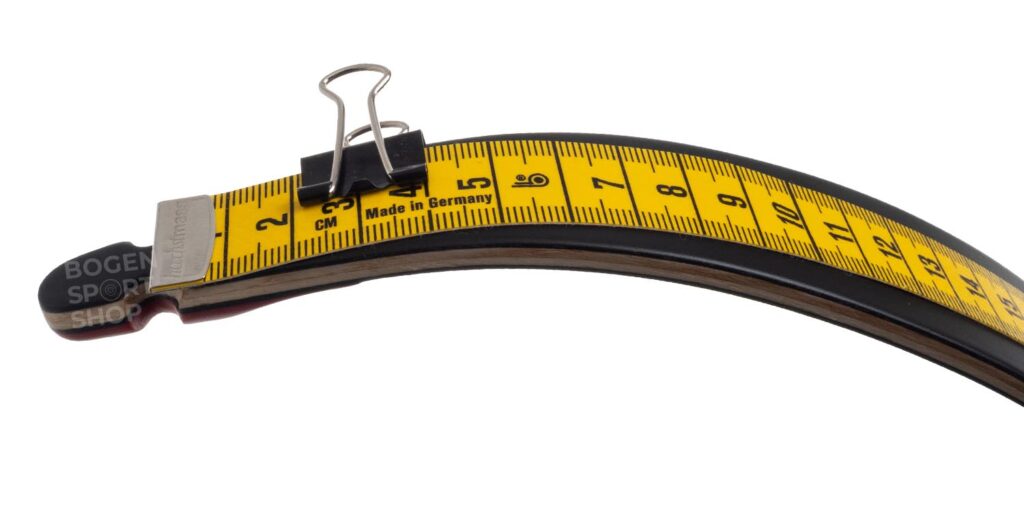
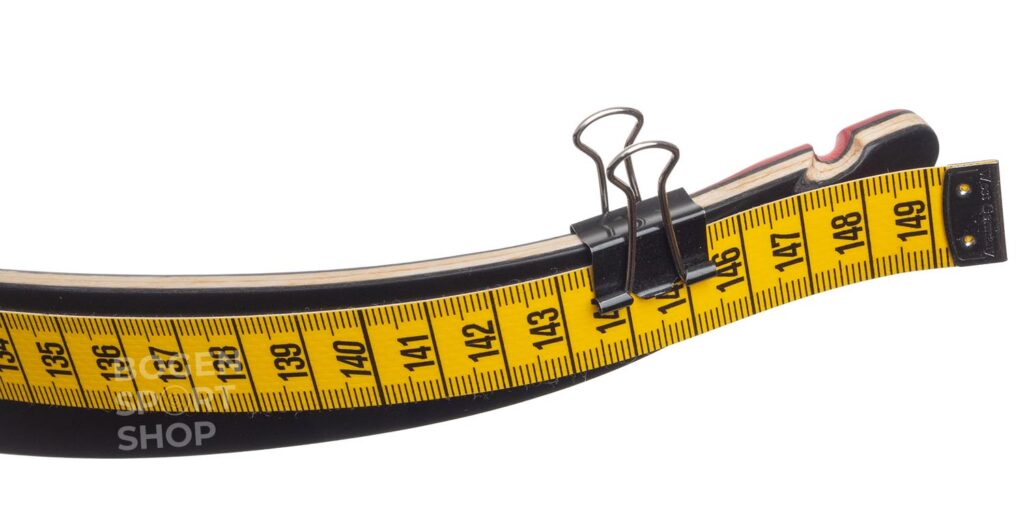
With this bow, it comes out to about 148 cm. That is 58.3″. So you can say quite confidently that it is probably a 58″ bow. So now that you have the bow length, you can determine the string length according to the table at the beginning of this blog post. Exactly according to AMO, the appropriate string would be 55″ long.
Or, to go into smart-ass mode one last time: If a 55″ long string results in a reasonable brace height, then it’s a „real“ 58″ bow according to AMO.
A much better option is to get a string that roughly fits. For example, from a fellow club member. Even if it is clearly too long, you can unstrung the bow and add twists to the string until you reach a reasonable brace height.
In this case, you can use the rough measurement to take a string from another 58″ bow, the string from a 60″ bow would also work, you just need to add many more twists. But that is okay, we don’t have to shoot with it, we really only need it for the measurement.
The topic of brace height is worth a blog post on it’s own, so I won’t go into detail here. Here are some usually recommended brace heights for orientation. These are not valid for all bows, the optimal brace height of each bow should be determined by shooting tests. The following numbers are therefore only to be understood as a starting point:
- 64 inch: 20.5 to 22 cm
- 66 inch: 21 to 22.8 cm
- 68 inch: 21.5 to 23.5 cm
- 70 inch: 22 to 24 cm
If the string is now twisted so that a good brace height is achieved, the length of the string can now be measured relatively well. No matter what nominal bow length the manufacturer has specified, you know the real string length you need. This is better than anything else.
How to actually measure string length is answered in the following.
I have a string, but I don’t know the length or what bow length it is suitable for. How do I find out?
If there is a suitable string, it is always much better to measure it than to derive a string length from the bow length. No matter how long the bow is supposed to be or what the manufacturer has written on it, a suitable string says more than 1000 measurements of the bow length.
The AMO has also commented on the measurement of a bowstring in its guidelines:
Bow string length is three inches less than bow length designation when loaded as per Bow String Tension Chart and stretched by placing string loops over 1/4″ diameter steel pins. Measurement is taken from outside the pin to outside of pin. Tolerance is ± 1/4″ after 20 seconds under tension load of chart.
– AMO Standards, Ed. 1987
So, the string is to be measured under tension via two steel pins with 1/4″ (approx. 6 mm) diameter. The mentioned table (Bow String Tension Chart) lists tensions from 35 to 170 lbs. (!) depending on bow length and draw weight of the bow.
Here I need to point out that the string material used at that time stretched significantly under load. That’s why it was so important to measure under a defined load and even to let it sit for a defined time. Today’s string material hardly stretches at all, so the tension plays a smaller role. What we should take away, however, are the steel pins with 6 mm diameter. And the string should already be well tensioned for a proper measurement. Whether this is 30 or 60 lbs, however, is not important.
The best way to measure the length of a bowstring is actually on a string jig. To this day, these are often supplied with 6 mm steel pins, which is of course no coincidence. And putting the string under tension also works well with a string jig.
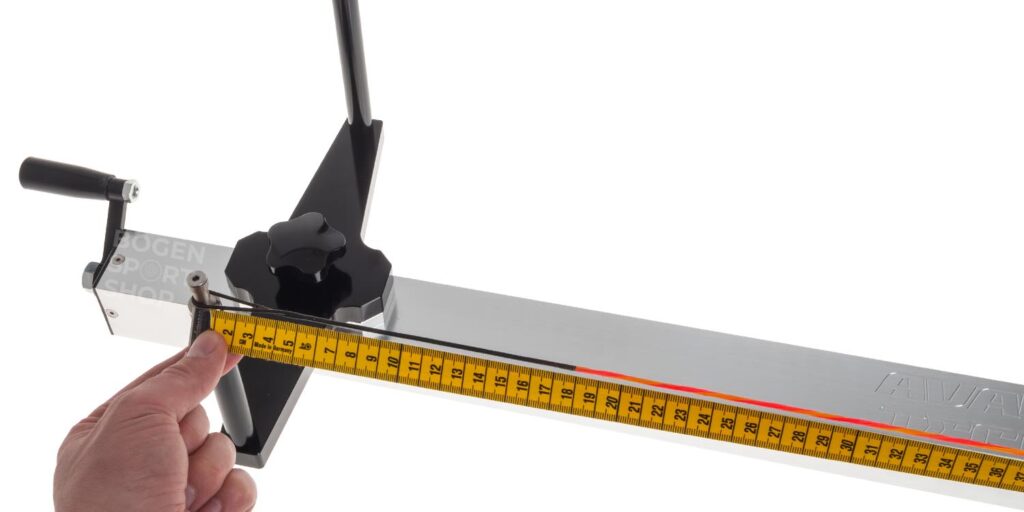
Alternatively, you can hang the string somewhere and put a weight on it.
If the pins are thinner than 6 mm, you will measure a little too much, and vice versa, too little if the pins are thicker than 6 mm. I did a rough calculation and the measurement error should be about 2 mm if the pins are only 3 mm thick. So I wouldn’t worry too much, should you have something suitable, with diameter of e.g. 5 mm or 8 mm. That should be accurate enough.
Especially since AMO specified a tolerance of 1/4″ (i.e. 6.35 mm) at the time. That’s a massive amount, but it’s actually realistic. The best manufacturers offer strings in increments of 0.5 cm. In my experience, this is also the tolerance at the same time, i.e. smaller increments are not feasible simply because of manufacturing tolerances. A 169 cm long bowstring is at least somewhere between 168.75 cm and 169.25 cm. If not between 168.5 cm and 169.5 cm. For cheap strings you can expect a real length between 168 cm and 170 cm.
Conclusion
Myths and rumors abound about the length of bows and strings, and many beginners are confused. But it is actually not that difficult.
Most of the bowstrings we offer are listed by bow length to make it even easier. That means: For a 70″ bow you simply select 70″, done. Beginners shouldn’t even worry about the actual length of the string. These are little details that will become important much later in the „career“, when the performance has developed accordingly.
For more experienced archers and those that need a bowstring with a length that deviates from the standard will find it with GAS Bowstrings, for example. These are available in increments of 0.5 cm. Ordering a special length is also no problem with custom string suppliers. From a certain level on, it is actually normal that strings are either self-made or custom-made from someone experienced. These archers need strings that are exactly tailored to them in terms of length, number of strands, string material, type and thickness of the serving material and thickness of the nock bed. An off-the-shelf string is then simply no longer sufficient.
If you decide to build your own bowstrings, you will of course find everything you need for that in our shop.




